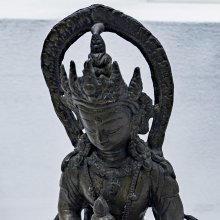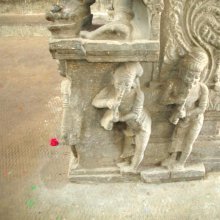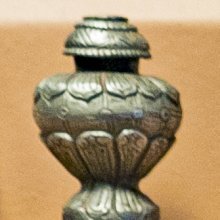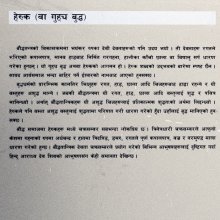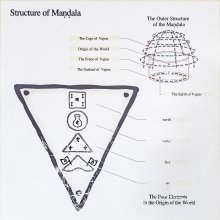Purna, Pūrṇa, Pūrṇā: 38 definitions
Introduction:
Purna means something in Buddhism, Pali, Hinduism, Sanskrit, Jainism, Prakrit, the history of ancient India, Marathi, Hindi, biology. If you want to know the exact meaning, history, etymology or English translation of this term then check out the descriptions on this page. Add your comment or reference to a book if you want to contribute to this summary article.
Images (photo gallery)
In Hinduism
Purana and Itihasa (epic history)
Source: Wisdom Library: Bhagavata PuranaPūrṇa (पूर्ण):—Son of Mīḍhvān (son of Ṛkṣa). He had a son named Indrasena. (see Bhāgavata Purāṇa 9.2)
Source: archive.org: Puranic Encyclopedia1) Pūrṇa (पूर्ण).—A serpent born of the family of Vāsuki. It was burnt to death at the Sarpasatra of Janamejaya. (Śloka 2, Chapter 57, Ādi Parva).
2) Pūrṇa (पूर्ण).—A Devagandharva born to Kaśyapa of his wife Pradhā. (Chapter 65, Ādi Parva).
3) Pūrṇā (पूर्णा).—The name of the tithis (lunar days) Pañcamī, Daśamī and Pañcadaśī. Yudhiṣṭhira was born on the Pañcamī day called Pūrṇā. (Śloka 6, Chapter 122, Ādi Parva).
Source: Cologne Digital Sanskrit Dictionaries: The Purana Index1) Pūrṇa (पूर्ण).—A son of Krodhā and a Deva-gandharva.*
- * Brahmāṇḍa-purāṇa III. 6. 38.
2) Pūrṇā (पूर्णा).—A Kalā of the moon.*
- * Brahmāṇḍa-purāṇa IV. 35. 92.
Pūrṇa (पूर्ण) is a name mentioned in the Mahābhārata (cf. I.31.6, I.35, I.52.5, I.57, I.59.45, I.65) and represents one of the many proper names used for people and places. Note: The Mahābhārata (mentioning Pūrṇa) is a Sanskrit epic poem consisting of 100,000 ślokas (metrical verses) and is over 2000 years old.

The Purana (पुराण, purāṇas) refers to Sanskrit literature preserving ancient India’s vast cultural history, including historical legends, religious ceremonies, various arts and sciences. The eighteen mahapuranas total over 400,000 shlokas (metrical couplets) and date to at least several centuries BCE.
Vastushastra (architecture)
Source: Wisdom Library: Vāstu-śāstraPūrṇa (पूर्ण) refers to a type of temple (prāsāda) classified, according to Samarāṅgaṇasūtradhāra chapter 57. The temple is mentioned as one of the six temples being a favorite of Śiva. The Samarāṅgaṇasūtradhāra is an 11th-century encyclopedia dealing with various topics from the Vāstuśāstra.

Vastushastra (वास्तुशास्त्र, vāstuśāstra) refers to the ancient Indian science (shastra) of architecture (vastu), dealing with topics such architecture, sculpture, town-building, fort building and various other constructions. Vastu also deals with the philosophy of the architectural relation with the cosmic universe.
Natyashastra (theatrics and dramaturgy)
Source: Wisdom Library: Nāṭya-śāstra1) Pūrṇa (पूर्ण, “full”) refers to a specific gesture (āṅgika) made with the cheeks (kapola or gaṇḍa), according to the Nāṭyaśāstra chapter 8. These gestures form a part of the histrionic representation (abhinaya). Instructions: (cheeks are) expanded. Uses: in energy and arrogance.
2) Pūrṇa (पूर्ण, “full”) refers to a specific gesture (āṅgika) made with the belly (udara), according to the Nāṭyaśāstra chapter 10. These gestures form a part of the histrionic representation (abhinaya). Instructions: The full belly is pūrṇa. Uses: In emitting breath, corpulence, disease, too much eating and the like.
Source: Wisdom Library: SaṅgītaśiromaṇiPūrṇa (पूर्ण, “complete”) refers to one of the ten good qualities (guṇa) of a song (gīta), according to the Saṅgītaśiromaṇi 14.75-76, where they are commonly known as the gītaguṇa. The Saṅgītaśiromaṇi (“crest-jewel of music”) is a 15th-century Sanskrit work on Indian musicology (gāndharvaśāstra). Accordingly, “when a song is complete in respect of its words (pada), notes (svara), sections (aṅga), variations (prayoga), meldoy (rāga) and poetical metre (chandas), it is complete (pūrṇa)”.
Source: archive.org: Natya ShastraPūrṇa (पूर्ण, “heptatonic”).—One of the four classes of mūrchāna (melody).—The seven notes (svara) combined in different orders (lit. having an order) are called ‘full’ or heptatonic (pūrṇa-mūrchanās).

Natyashastra (नाट्यशास्त्र, nāṭyaśāstra) refers to both the ancient Indian tradition (shastra) of performing arts, (natya—theatrics, drama, dance, music), as well as the name of a Sanskrit work dealing with these subjects. It also teaches the rules for composing Dramatic plays (nataka), construction and performance of Theater, and Poetic works (kavya).
Pancaratra (worship of Nārāyaṇa)
Source: Wisdom Library: PāñcarātraPūrṇa (पूर्ण) refers to an aspect of nṛsiṃha (‘man-lion’), according to the Vihagendra-saṃhitā 4.17, which mentions seventy-four forms (inlcuding twenty forms of vyūha). He is also known as Pūrṇanṛsiṃha or Pūrṇanarasiṃha. Nṛsiṃha is a Tantric deity and refers to the furious (ugra) incarnation of Viṣṇu.
The 15th-century Vihagendra-saṃhīta is a canonical text of the Pāñcarātra corpus and, in twenty-four chapters, deals primarely with meditation on mantras and sacrificial oblations.

Pancaratra (पाञ्चरात्र, pāñcarātra) represents a tradition of Hinduism where Narayana is revered and worshipped. Closeley related to Vaishnavism, the Pancaratra literature includes various Agamas and tantras incorporating many Vaishnava philosophies.
Jyotisha (astronomy and astrology)
Source: academia.edu: Tithikarmaguṇa in GārgīyajyotiṣaPūrṇā (पूर्णा) or Pūrṇatithi is the name of the fifth of fifteen tithis (cycle of time) according to both the Gārgīyajyotiṣa and the Śārdūlakarṇāvadāna. The associated deity for Pūrṇā according to the Bṛhatsaṃhitā is Śaśāṅka. A tithi was defined as one thirtieth of a synodic month (c. 29.5 days), resulting in an average tithi being slightly less than a day.
Accordingly, “(19) The fifth tithi is called Pūrṇā. One should perform firm acts, of the ceremony of consuming new grain, oblation of the first fruits, and of beds, seats and houses. (20) One should engage in activities related to birth, fields, ornaments,
wealth, commerce and medicine. Works of nourishing nature are auspicious. One should know Soma as the deity”.
Pūrṇa (पूर्ण).—Full, complete. Note: Pūrṇa is a Sanskrit technical term used in ancient Indian sciences such as Astronomy, Mathematics and Geometry.

Jyotisha (ज्योतिष, jyotiṣa or jyotish) refers to ‘astronomy’ or “Vedic astrology” and represents the fifth of the six Vedangas (additional sciences to be studied along with the Vedas). Jyotisha concerns itself with the study and prediction of the movements of celestial bodies, in order to calculate the auspicious time for rituals and ceremonies.
Shaktism (Shakta philosophy)
Source: Google Books: Manthanabhairavatantram1) Pūrṇa (पूर्ण) or Pūrṇapīṭha refers to one of the Pīṭhas (“sacred seats”) where the god unites with the goddess according to the Ambāmatasaṃhitā.—Accordingly, “When the dvāpara (Age) came, (the goddess) went to the venerable cave (gahvara) of (the sacred seat called) Pūrṇa and, having assumed the form of a Śāvarī, became of benefit to (the whole) universe. (Similarly, the god), having attained the power of the knowledge (of the teachings), arose (there) in order to sport (with the goddess). [...]”.
2) Pūrṇa (पूर्ण) or Ekakoṇa refers to the Cremation Ground associated with Pūrṇagiri, one of the eight Sacred Seats (pīṭha), according to the Yogakhaṇḍa (chapter 14) of the Manthānabhairavatantra, a vast sprawling work that belongs to a corpus of Tantric texts concerned with the worship of the goddess Kubjikā.
Source: Brill: Śaivism and the Tantric Traditions (shaktism)Pūrṇa (पूर्ण) or Pūrṇacandra refers to the “full (moon)”, according to Sāhib Kaul’s Śārikāstrotra.—Accordingly, “[...] My devotion to you nourishes me every day, as the rise of the full moon (pūrṇa-candra-udaya) always nourishes the ocean. On account of the true affluence of victorious devotion to you I even ignore the excellent Lakṣmī. The whole world consists of you, Goddess of Gods! Your body is consciousness, you are alone and perfectly established. Nowhere is there ignorance. Thus, where do we see the son of a barren woman run and raise his bow? [...]”.

Shakta (शाक्त, śākta) or Shaktism (śāktism) represents a tradition of Hinduism where the Goddess (Devi) is revered and worshipped. Shakta literature includes a range of scriptures, including various Agamas and Tantras, although its roots may be traced back to the Vedas.
Vaishnavism (Vaishava dharma)
Source: Brill: Śaivism and the Tantric Traditions (vaishnavism)Pūrṇa (पूर्ण) refers to the “full (moon)”, according to the Vedānta Deśika’s Yatirājasaptati.—When we come to the poem’s understanding of the divinity of Rāmānuja we find a wide spectrum of meanings. [...] Verse 28 is particularly eloquent in describing and encapsulating all his nurturing and protecting qualities, which are compared to those present everywhere in nature itself—as the mountain from which originate all the streams of knowledge, the tree under which the weary traveler wandering in saṃsāra takes rest, the rising sun that keeps the illusionary darkness of those with distorted views at bay and the full moon (pūrṇa-candra) that brings to high tide the ocean of the Vedas.

Vaishnava (वैष्णव, vaiṣṇava) or vaishnavism (vaiṣṇavism) represents a tradition of Hinduism worshipping Vishnu as the supreme Lord. Similar to the Shaktism and Shaivism traditions, Vaishnavism also developed as an individual movement, famous for its exposition of the dashavatara (‘ten avatars of Vishnu’).
Shaivism (Shaiva philosophy)
Source: Brill: Śaivism and the Tantric TraditionsPūrṇa (पूर्ण) or “full” refers to the “(the realm of) akula”, according to Jayaratha ad Nityāṣoḍaśikārṇava verse 4.14.—Accordingly, “Then leaving behind the kula, i.e. the body, she goes to the one who is in the realm of akula, the supreme, i.e. full (pūrṇa) […] Person, the highest authority, who is without a body and without bodily form, with his innate nature manifest and therefore lacking qualities, i.e. she reaches oneness with Him. This is the meaning [of this verse]”.

Shaiva (शैव, śaiva) or Shaivism (śaivism) represents a tradition of Hinduism worshiping Shiva as the supreme being. Closely related to Shaktism, Shaiva literature includes a range of scriptures, including Tantras, while the root of this tradition may be traced back to the ancient Vedas.
Ganitashastra (Mathematics and Algebra)
Source: archive.org: Hindu MathematicsPūrṇa (पूर्ण) represents the number 0 (zero) in the “word-numeral system” (bhūtasaṃkhyā), which was used in Sanskrit texts dealing with astronomy, mathematics, metrics, as well as in the dates of inscriptions and manuscripts in ancient Indian literature.—A system of expressing numbers by means of words arranged as in the place-value notation was developed and perfected in India in the early centuries of the Christian era. In this system the numerals [e.g., 0—pūrṇa] are expressed by names of things, beings or concepts, which, naturally or in accordance with the teaching of the Śāstras, connote numbers.

Ganitashastra (शिल्पशास्त्र, gaṇitaśāstra) refers to the ancient Indian science of mathematics, algebra, number theory, arithmetic, etc. Closely allied with astronomy, both were commonly taught and studied in universities, even since the 1st millennium BCE. Ganita-shastra also includes ritualistic math-books such as the Shulba-sutras.
Ayurveda (science of life)
Agriculture (Krishi) and Vrikshayurveda (study of Plant life)
Source: Shodhganga: Drumavichitrikarnam—Plant mutagenesis in ancient IndiaPūrṇa (पूर्ण) refers to “filling (the base near the roots)” (of the trees) according to the various bio-organical recipes for plant mutagenesis, according to the Vṛkṣāyurveda by Sūrapāla (1000 CE): an encyclopedic work dealing with the study of trees and the principles of ancient Indian agriculture.—Accordingly, “Fragrance of the blossom can be changed by filling (the base near) the roots (pūrṇa-mūla) of the trees with the earth scented with the desired fragrance and then fed with water mixed with Cyperus rotundus, Erythrina stricta, Valeriana wallichii, Aporosa lindleyana and Cinnamomum tamala”.

Āyurveda (आयुर्वेद, ayurveda) is a branch of Indian science dealing with medicine, herbalism, taxology, anatomy, surgery, alchemy and related topics. Traditional practice of Āyurveda in ancient India dates back to at least the first millenium BC. Literature is commonly written in Sanskrit using various poetic metres.
In Buddhism
Tibetan Buddhism (Vajrayana or tantric Buddhism)
Source: Wisdom Library: Tibetan BuddhismPūrṇa (पूर्ण) is the name of a Śrāvaka mentioned as attending the teachings in the 6th century Mañjuśrīmūlakalpa: one of the largest Kriyā Tantras devoted to Mañjuśrī (the Bodhisattva of wisdom) representing an encyclopedia of knowledge primarily concerned with ritualistic elements in Buddhism. The teachings in this text originate from Mañjuśrī and were taught to and by Buddha Śākyamuni in the presence of a large audience (including Pūrṇa).

Tibetan Buddhism includes schools such as Nyingma, Kadampa, Kagyu and Gelug. Their primary canon of literature is divided in two broad categories: The Kangyur, which consists of Buddha’s words, and the Tengyur, which includes commentaries from various sources. Esotericism and tantra techniques (vajrayāna) are collected indepently.
General definition (in Buddhism)
Source: academia.edu: The Chronological History of BuddhismGhosha and Purna Maitrayaniputra (1165-1080 BCE) Ghosha and Purna were the illustrious philosophers of Sarvastivada. According to Indian and Tibetan traditions, Purna was the author of Dhatukayapada, one of the seven treatises of the Abhidharma of Sarvastivada.
In Jainism
General definition (in Jainism)
Source: archive.org: TrisastisalakapurusacaritraPūrṇa (पूर्ण) and Avaśiṣṭa are the two Indras of the Dvīpakumāras who came to the peak of Meru for partaking in the birth-ceremonies of Ṛṣabha, according to chapter 1.2 [ādīśvara-caritra] of Hemacandra’s 11th century Triṣaṣṭiśalākāpuruṣacaritra: an ancient Sanskrit epic poem narrating the history and legends of sixty-three illustrious persons in Jainism.
Source: Encyclopedia of Jainism: Tattvartha Sutra 4: The celestial beings (deva)Pūrṇa (पूर्ण) refers to one of the two Indras (lords) of the Dvīpakumāra (island youths) class of “residential celestial beings” (bhavanavāsin), itself a main division of devas (celestial beings) according to the 2nd-century Tattvārthasūtra 4.3. The Dvīpakumāras perform miraculous activities in the continents. Pūrṇa and Vaśiṣṭa (Vasiṣṭha?) are the two lords in the Fiendish-youths residential celestial beings.
Source: The University of Sydney: A study of the Twelve ReflectionsPūrṇa (पूर्ण) refers to “(being) filled”, according to the 11th century Jñānārṇava, a treatise on Jain Yoga in roughly 2200 Sanskrit verses composed by Śubhacandra.—Accordingly, “Where is the body, which is filled (pūrna) with blood, flesh and fat, has a skeleton of slender bones, is bound with tendons and is of bad odour, praised? Continually pouring forth putrid smells through [its] nine orifices, the human body is ever perishable [and] dependent on other [things]”.
Synonyms: Vyāpta, Ākīrṇa, Avakīrṇa, Ālīḍha, Samālīḍha, Samākīrṇa, Saṃbhṛta.

Jainism is an Indian religion of Dharma whose doctrine revolves around harmlessness (ahimsa) towards every living being. The two major branches (Digambara and Svetambara) of Jainism stimulate self-control (or, shramana, ‘self-reliance’) and spiritual development through a path of peace for the soul to progess to the ultimate goal.
India history and geography
Source: Cologne Digital Sanskrit Dictionaries: Indian Epigraphical GlossaryPūrṇa.—(IE 7-1-2), ‘cypher’. Note: pūrṇa is defined in the “Indian epigraphical glossary” as it can be found on ancient inscriptions commonly written in Sanskrit, Prakrit or Dravidian languages.

The history of India traces the identification of countries, villages, towns and other regions of India, as well as mythology, zoology, royal dynasties, rulers, tribes, local festivities and traditions and regional languages. Ancient India enjoyed religious freedom and encourages the path of Dharma, a concept common to Buddhism, Hinduism, and Jainism.
Biology (plants and animals)
Source: Wisdom Library: Local Names of Plants and DrugsPurna in the Tamil language is the name of a plant identified with Cadaba trifoliata Wight & Arn. from the Capparaceae (Caper) family having the following synonyms: Cadaba triphylla, Desmocarpus missionis. For the possible medicinal usage of purna, you can check this page for potential sources and references, although be aware that any some or none of the side-effects may not be mentioned here, wether they be harmful or beneficial to health.
Source: Google Books: CRC World Dictionary (Regional names)Purna in India is the name of a plant defined with Cadaba trifoliata in various botanical sources. This page contains potential references in Ayurveda, modern medicine, and other folk traditions or local practices.
Example references for further research on medicinal uses or toxicity (see latin names for full list):
· Cat. Ind. Pl. (1833)
· Prodr. Flora Indica, or ‘Descriptions of Indian Plants’ Orient. (1834)
If you are looking for specific details regarding Purna, for example health benefits, extract dosage, pregnancy safety, diet and recipes, side effects, chemical composition, have a look at these references.

This sections includes definitions from the five kingdoms of living things: Animals, Plants, Fungi, Protists and Monera. It will include both the official binomial nomenclature (scientific names usually in Latin) as well as regional spellings and variants.
Languages of India and abroad
Marathi-English dictionary
Source: DDSA: The Molesworth Marathi and English Dictionarypūrṇa (पूर्ण).—p (S) Full, filled, complete, perfect, entire; deficient in no quantity, part, or member. Used lit. fig. 2 Perfect, adept, thoroughly versed and skilled in.
--- OR ---
pūrṇa (पूर्ण).—n S The name of the cipher applied in almanacks &c. to denote the absence or total want of any particular division among the divisions or distinguished portions of time. Ex. ā- ditvārīṃ ṣaṣṭhī pūrṇa ghaṭikā pāñca palēṃ. On sunday the sixth, ghaṭikā wanting, five palēṃ.
--- OR ---
pūrṇā (पूर्णा).—f S A term for the days of change and full and for the 5th and 10th of the moon.
Source: DDSA: The Aryabhusan school dictionary, Marathi-Englishpūrṇa (पूर्ण).—p Full. Perfect. Adept.
Marathi is an Indo-European language having over 70 million native speakers people in (predominantly) Maharashtra India. Marathi, like many other Indo-Aryan languages, evolved from early forms of Prakrit, which itself is a subset of Sanskrit, one of the most ancient languages of the world.
Sanskrit dictionary
Source: DDSA: The practical Sanskrit-English dictionaryPūrṇa (पूर्ण).—p. p. [pur-kta ni°]
1) Filled, filled with, full of; opt. in comp; तं तथा कृपयाविष्टमश्रुपूर्णाकुलेक्षणम् (taṃ tathā kṛpayāviṣṭamaśrupūrṇākulekṣaṇam) Bhagavadgītā (Bombay) 2.1; so शोक°, जल° (śoka°, jala°) &c.
2) Whole, full, entire, complete; पूर्णमदः पूर्णमिदं पूर्णात् पूर्णमुदच्यते (pūrṇamadaḥ pūrṇamidaṃ pūrṇāt pūrṇamudacyate) Īśop.1; अपूर्णमेकेन शतक्रतूपमः (apūrṇamekena śatakratūpamaḥ) R.3.38.
3) Fulfilled, accomplished.
4) Ended, completed.
5) Past, elapsed.
6) Satisfied, contented.
7) Full-sounding, sonorous.
8) Strong, powerful.
9) Selfish, or self-indulgent.
1) Drawn, bent (as a bow) आकर्णपूर्णै- रहनदाक्षेपैराहतं पुनः (ākarṇapūrṇai- rahanadākṣepairāhataṃ punaḥ) Bhāgavata 8.11.1.
11) Allpervading; पूर्णमप्रवर्तीति वा अहमेतमुपास (pūrṇamapravartīti vā ahametamupāsa) Bṛ. Up.2.1.5; Mahābhārata (Bombay) 14.2.28.
-rṇā 1 An epithet of the fifteenth digit of the moon.
2) Name of the fifth, tenth, and fifteenth lunar days or tithis.
-rṇam Ved.
1) Abundance, plenty.
2) Water.
Source: Cologne Digital Sanskrit Dictionaries: Edgerton Buddhist Hybrid Sanskrit DictionaryPūrṇa (पूर्ण).—adj. and n. pr. (proper name) (adj. as in Sanskrit, full, with numerals; wrong division in edd., notably that of Saddharmapuṇḍarīka, often makes the construction seem strange, when it is really quite normal Sanskrit, e.g. [read] aṣṭādaśa kṣetrasahasra pūrṇāḥ [ed. as one word!] Saddharmapuṇḍarīka 9.3 and 24.1; aśīti so antara- kalpa pūrṇāṃ [with aśīti, acc.] 26.12; aśīti pūrṇāḥ 62.3 [ed. as one word]; dvātriṃśatī [so mss., acc.] antarakalpa [so divide] pūrṇāṃ 68.11; compare next verse, dvātriṃśatī antara- kalpa sthāsyatī 69.1; note the same use of paripūrṇa, in: °ṇa so antarakalpa [so divide] ṣaṣṭim 25.8, for full 60 intermediate kalpas; sahasr' aśītiḥ paripūrṇa ye sthitāḥ 35.12; all these are verses), (1) also Pūrṇaka (1), Saṃpūrṇa, qq.v. (= Pali Puṇṇa, -ka, No. 1 in Malalasekara (Dictionary of Pali Proper Names)), name of a sthavira, a well-known disciple of Buddha; his story is told Avadāna-śataka i.2.8 ff. (here always called Pūrṇa except twice Saṃpūrṇa, q.v.); and more fully Divyāvadāna 26.8 ff. (here regularly Pūrṇa, occasionally Pūrṇaka without difference of meaning); a fragment of the story in Mahāvastu, with name Pūrṇako i.245.10; referred to as Pūrṇa Jātakamālā 115.23; Karmavibhaṅga (and Karmavibhaṅgopadeśa) 63.3; (2) Pūrṇa Maitrāyaṇīputra (= Pali Puṇṇa Mantānīputta), name of another disciple of Buddha: as two separate words Mahāvastu iii.377.13 (here Maitrāyaṇīye…putro); 379.3, 12, 17; 382.7; Saddharmapuṇḍarīka 199.1; 200.1, etc.; as one [compound] word, Pūrṇa- Maitrāyaṇīputra, Saddharmapuṇḍarīka 2.7; EV 1.15; Mahāvyutpatti 1036; Gaṇḍavyūha 17.23; and so Sukhāvatīvyūha 2.4, where he seems to be confused with Pūrṇa (3), see s.v. Yaśodeva; (3) name of another disciple of Buddha, corresp. to Pali Puṇṇaji, which should = Pūr- ṇajit: Lalitavistara 1.9 and Sukhāvatīvyūha 2.4, above (see Yaśodeva); (4) name of another disciple of Buddha (the same as 1 ?) called Kuṇḍopadhānīyaka, q.v. (once also Pūrṇaka): Divyāvadāna 44.8; 45.1; (5) name of a former Buddha: Avadāna-śataka i.117.10 ff.; see Saṃpūrṇa 2: (6) (= Pali Puṇṇaka; also [Buddhist Hybrid Sanskrit] Pūrṇaka 3), name of a yakṣa: Sādhanamālā 562.20 (prose).
--- OR ---
Pūrṇa (पूर्ण) or Pūrṇaka.—(1) (1): Mahāvastu i.245.10; Divyāvadāna 29.22, 26; 30.5, 10, 14, 16; 31.22; 40.18; 44.15; only the last is in a verse, the rest are prose, often occurring close to the form Pūrṇa which is much commoner, and without any discernible difference of meaning; (2) = Pūrṇa (4): only in a verse, Divyāvadāna 44.15; (3) = Pūrṇa (6): Mahā-Māyūrī 40; 54; 235.12; 236.29; (4) adj. pūrṇaka (= Sanskrit pūrṇa; nowhere recorded [Page351-b+ 71] in this meaning), full: pañcāśa varsāṇi su-pūrṇakāni Saddharmapuṇḍarīka 115.7 (verse), full 50 years; here perhaps -ka m.c.; but prose in Mūla-Sarvāstivāda-Vinaya i.252.20 (same passage Divyāvadāna 133.24 pūrṇa).
--- OR ---
Pūrṇa (पूर्ण) or Saṃpūrṇa.—(1) 1, name of a disciple of Śākyamuni: Avadāna-śataka i.2.2 (here ms. Sa-p°); 3.1; (2) name of a Buddha (possibly = Pūrṇa 5): (Ārya-)Mañjuśrīmūlakalpa 499.23 (verse).
Source: Cologne Digital Sanskrit Dictionaries: Shabda-Sagara Sanskrit-English DictionaryPūrṇa (पूर्ण).—mfn.
(-rṇaḥ-rṇā-rṇaṃ) 1. Full, filled, complete. 2. All, entire. 3. Strong, powerful, able. 4. Selfish, self-indulgent. f.
(-rṇā) 1. Fifth, tenth, or fifteenth day of the half month. 2. Full moon. E. pūr to be full, aff. kta, form irr.
Source: Cologne Digital Sanskrit Dictionaries: Cappeller Sanskrit-English DictionaryPūrṇa (पूर्ण).—[adjective] filled, full; full of, rich in ([instrumental], [genetive], or —°), complete, abundant; fulfilled, accomplished, satisfied.
Source: Cologne Digital Sanskrit Dictionaries: Monier-Williams Sanskrit-English Dictionary1) Pūrṇa (पूर्ण):—[from pūra] mfn. filled, full, filled with or full of ([instrumental case] or [genitive case] or [compound]), [Ṛg-veda] etc. etc.
2) [v.s. ...] abundant, rich, [Kāvya literature]
3) [v.s. ...] fulfilled, finished, accomplished, ended, past, [Śāṅkhāyana-gṛhya-sūtra; Mahābhārata; Rāmāyaṇa] etc.
4) [v.s. ...] concluded (as a treaty), [Rājataraṅgiṇī]
5) [v.s. ...] complete, all, entire, [Śāṅkhāyana-brāhmaṇa; Manu-smṛti; Mahābhārata] etc.
6) [v.s. ...] satisfied, contented, [Rāmāyaṇa]
7) [v.s. ...] (ifc.) perfectly familiar with, [Hemādri’s Caturvarga-cintāmaṇi]
8) [v.s. ...] drawn, bent to the full (as a bow), [Mahābhārata; Harivaṃśa]
9) [v.s. ...] (in augury) full-sounding, sonorous and auspicious (said of the cry of birds and beasts, opp. to dīpta q.v.)
10) [v.s. ...] uttering this cry, [Varāha-mihira’s Bṛhat-saṃhitā]
11) [v.s. ...] strong, capable, able, [cf. Lexicographers, esp. such as amarasiṃha, halāyudha, hemacandra, etc.]
12) [v.s. ...] selfish, self-indulgent, [Horace H. Wilson]
13) [v.s. ...] m. a [particular] form of the sun, [Catalogue(s)]
14) [v.s. ...] a kind of tree, [Rāmāyaṇa]
15) [v.s. ...] (in music) a [particular] measure
16) [v.s. ...] Name of a Nāga, [Mahābhārata]
17) [v.s. ...] of a Deva-gandharva, [ib.]
18) [v.s. ...] of a Buddhist ascetic, [Lalita-vistara]
19) Pūrṇā (पूर्णा):—[from pūrṇa > pūra] f. Name of the 15th Kalā of the month, [Brahma-purāṇa]
20) [v.s. ...] of the 5th, 10th and 15th Tithis, [Varāha-mihira]
21) [v.s. ...] Name of a woman, [Vetāla-pañcaviṃśatikā]
22) [v.s. ...] (with Śāktas) of an authoress of Mantras, [Catalogue(s)]
23) [v.s. ...] of 2 rivers, [Viṣṇu-purāṇa]
24) Pūrṇa (पूर्ण):—[from pūra] n. fulness, plenty, abundance, [Atharva-veda; Taittirīya-saṃhitā]
25) [v.s. ...] m. water, [Naighaṇṭuka, commented on by Yāska i, 12]
26) [v.s. ...] the cipher or figure 0 [Gaṇitādhyāya]
Source: Cologne Digital Sanskrit Dictionaries: Yates Sanskrit-English Dictionary1) Pūrṇa (पूर्ण):—(ka) pūrṇayati 10. a. To fill.
2) [(rṇaḥ-rṇā-rṇaṃ) a.] Full; all; strong; self-sufficient. f. (rṇā) 10th or 15th of the half month; full moon.
Source: DDSA: Paia-sadda-mahannavo; a comprehensive Prakrit Hindi dictionary (S)Pūrṇa (पूर्ण) in the Sanskrit language is related to the Prakrit words: Agghaviya, Puṇṇa, Puṇṇā.
[Sanskrit to German]
Sanskrit, also spelled संस्कृतम् (saṃskṛtam), is an ancient language of India commonly seen as the grandmother of the Indo-European language family (even English!). Closely allied with Prakrit and Pali, Sanskrit is more exhaustive in both grammar and terms and has the most extensive collection of literature in the world, greatly surpassing its sister-languages Greek and Latin.
Hindi dictionary
Source: DDSA: A practical Hindi-English dictionary1) Purna in Hindi refers in English to:—(v) to fill; to complete, to supplement; to work a design on the floor with coloured chalk, flour or rice, etc..—purna (पूरना) is alternatively transliterated as Pūranā.
2) Pūrṇa (पूर्ण) [Also spelled purn]:—(a) complete, whole, entire; full; perfect; absolute; sufficient; finished, accomplished; plenary; ~[kāma] fulfilled/gratified; ~[kālika] whole-time; ~[caṃdra] full moon; ~[prajña] perfect in wisdom, having thorough knowledge; —[mānadaṃḍa] absolute standard; —[virāma] full stop, —[viveka] absolute discretion; perfect reason; —[śaktimattā] totipotence; —[śaktimāna] totipotent; —[saṃkhyā] integral number.
...
Kannada-English dictionary
Source: Alar: Kannada-English corpusPūrṇa (ಪೂರ್ಣ):—
1) [adjective] containing as much or as many as is possible or normal; full.
2) [adjective] complete especially in detail, number or duration.
3) [adjective] not lacking in any essential; perfect.
4) [adjective] completed; accomplished; done fully.
5) [adjective] able; capable; competent.
6) [adjective] bent; caused to bow.
--- OR ---
Pūrṇa (ಪೂರ್ಣ):—
1) [noun] = ಪೂರಣ - [purana -] 5 & 7.
2) [noun] the quality of being complex, having more parts, persons, things connected with each other.
3) [noun] (dance) a blowing of cheeks from within.
Kannada is a Dravidian language (as opposed to the Indo-European language family) mainly spoken in the southwestern region of India.
See also (Relevant definitions)
Starts with (+205): Purna-aparadha, Purna-ardrata, Purna-nyaayaadhikaran, Purna-nyayadhikarana, Purna-nyayadhiveshana, Purna-samanupatika-pranali, Purna-santushtiko-bindu, Purnabandhura, Purnabhadra, Purnabhadrika, Purnabhaga, Purnabhedini, Purnabhilasha, Purnabhisheka, Purnabhishekapaddhati, Purnabhishekavidhi, Purnabhishikta, Purnabhrarasa, Purnabija, Purnabodha.
Ends with (+98): Abhipurna, Adeshapurna, Adhikarapurna, Agnipurna, Agrahapurna, Akshatapurna, Ambhapurna, Anandapurna, Annapurna, Aparadhapurna, Aparipurna, Apurna, Ardhapurna, Arthapurna, Asampurna, Ashruparipurna, Ashrupurna, Ashvapurna, Asrikpurna, Atulapurna.
Full-text (+607): Punna, Annapurna, Agghaviya, Purnamaitrayaniputra, Purnamasa, Purnakama, Purnapatra, Purnasha, Purnam, Purnakha, Purnanaka, Purna-nyaayaadhikaran, Purnakumbha, Purnata, Purnama, Sampurna, Purnakakuda, Purnabija, Purnaratha, Purnamanasa.
Relevant text
Search found 127 books and stories containing Purna, Pūrṇa, Pūrṇā; (plurals include: Purnas, Pūrṇas, Pūrṇās). You can also click to the full overview containing English textual excerpts. Below are direct links for the most relevant articles:
Garga Samhita (English) (by Danavir Goswami)
Verse 2.16.26 < [Chapter 16 - The Worship of Tulasī]
Verse 2.9.45 < [Chapter 9 - Brahmā’s Prayers]
Verse 1.15.30 < [Chapter 15 - Revelation of the Universal Form to Nanda’s Wife]
Chaitanya Bhagavata (by Bhumipati Dāsa)
Verse 3.1.158 < [Chapter 1 - Meeting Again at the House of Śrī Advaita Ācārya]
Verse 3.3.406 < [Chapter 3 - Mahāprabhu’s Deliverance of Sarvabhauma, Exhibition of His Six-armed Form, and Journey to Bengal]
Verse 3.3.518 < [Chapter 3 - Mahāprabhu’s Deliverance of Sarvabhauma, Exhibition of His Six-armed Form, and Journey to Bengal]
Rig Veda (translation and commentary) (by H. H. Wilson)
Bhagavatpadabhyudaya by Lakshmana Suri (study) (by Lathika M. P.)
Pūrṇa River < [Chapter 4 - Similarities and Dissimilarities]
The River Cūrṇa < [Chapter 4 - Similarities and Dissimilarities]
Canto III—Depicting of Paramahaṃsa < [Chapter 2 - Content Analysis of Bhagavatpādābhyudaya]
Sahitya-kaumudi by Baladeva Vidyabhushana (by Gaurapada Dāsa)
Text 10.49 < [Chapter 10 - Ornaments of Meaning]
Text 4.60 < [Chapter 4 - First-rate Poetry]
Text 10.2 < [Chapter 10 - Ornaments of Meaning]
Brihad Bhagavatamrita (commentary) (by Śrī Śrīmad Bhaktivedānta Nārāyana Gosvāmī Mahārāja)
Verse 2.2.26 < [Chapter 2 - Jñāna (knowledge)]
Verse 2.1.174-175 < [Chapter 1 - Vairāgya (renunciation)]
Verse 2.1.7 < [Chapter 1 - Vairāgya (renunciation)]
Related products
